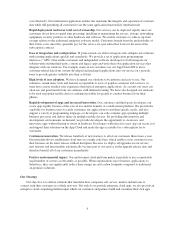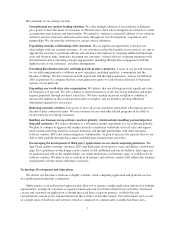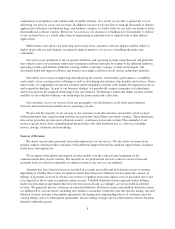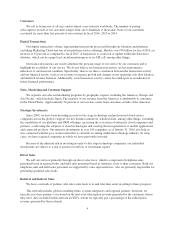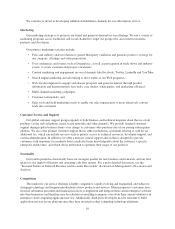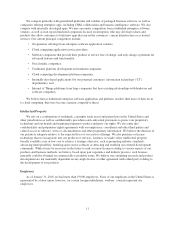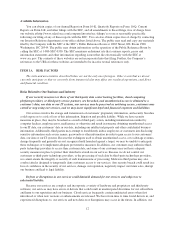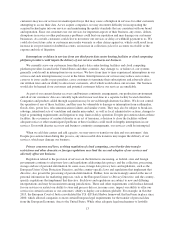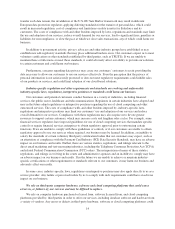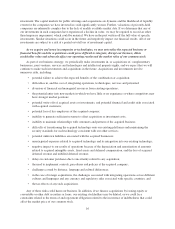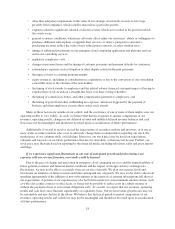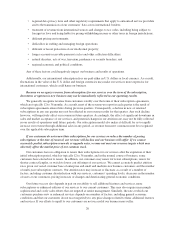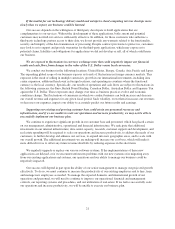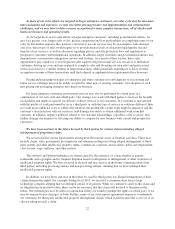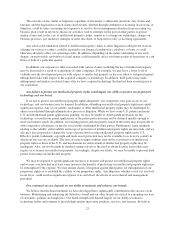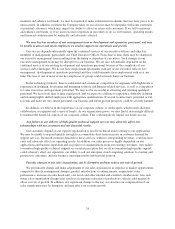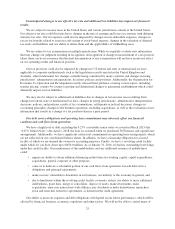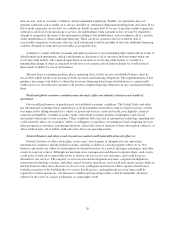Salesforce.com 2016 Annual Report Download - page 23
Download and view the complete annual report
Please find page 23 of the 2016 Salesforce.com annual report below. You can navigate through the pages in the report by either clicking on the pages listed below, or by using the keyword search tool below to find specific information within the annual report.investment. The capital markets for public offerings and acquisitions are dynamic and the likelihood of liquidity
events for the companies we have invested in could significantly worsen. Further, valuations of privately-held
companies are inherently complex due to the lack of readily available market data. If we determine that any of
our investments in such companies have experienced a decline in value, we may be required to record an other
than temporary impairment, which could be material. We have in the past written off the full value of specific
investments. Similar situations could occur in the future and negatively impact our financial results. All of our
investments are subject to a risk of a partial or total loss of investment capital.
As we acquire and invest in companies or technologies, we may not realize the expected business or
financial benefits and the acquisitions could prove difficult to integrate, disrupt our business, dilute
stockholder value and adversely affect our operating results and the market value of our common stock.
As part of our business strategy, we periodically make investments in, or acquisitions of, complementary
businesses, joint ventures, services and technologies and intellectual property rights, and we expect that we will
continue to make such investments and acquisitions in the future. Acquisitions and investments involve
numerous risks, including:
• potential failure to achieve the expected benefits of the combination or acquisition;
• difficulties in, and the cost of, integrating operations, technologies, services and personnel;
• diversion of financial and managerial resources from existing operations;
• the potential entry into new markets in which we have little or no experience or where competitors may
have stronger market positions;
• potential write-offs of acquired assets or investments, and potential financial and credit risks associated
with acquired customers;
• potential loss of key employees of the acquired company;
• inability to generate sufficient revenue to offset acquisition or investment costs;
• inability to maintain relationships with customers and partners of the acquired business;
• difficulty of transitioning the acquired technology onto our existing platforms and maintaining the
security standards for such technology consistent with our other services;
• potential unknown liabilities associated with the acquired businesses;
• unanticipated expenses related to acquired technology and its integration into our existing technology;
• negative impact to our results of operations because of the depreciation and amortization of amounts
related to acquired intangible assets, fixed assets and deferred compensation, and the loss of acquired
deferred revenue and unbilled deferred revenue;
• delays in customer purchases due to uncertainty related to any acquisition;
• the need to implement controls, procedures and policies at the acquired company;
• challenges caused by distance, language and cultural differences;
• in the case of foreign acquisitions, the challenges associated with integrating operations across different
cultures and languages and any currency and regulatory risks associated with specific countries; and
• the tax effects of any such acquisitions.
Any of these risks could harm our business. In addition, if we finance acquisitions by issuing equity or
convertible or other debt securities or loans, our existing stockholders may be diluted, or we could face
constraints related to the terms of and repayment obligation related to the incurrence of indebtedness that could
affect the market price of our common stock.
16


